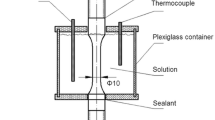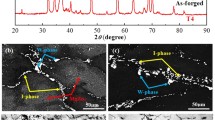Abstract
Recent studies have revealed that the mechanism of stress-corrosion cracking (SCC) of high-strength Al-Zn-Mg alloys involves both dissolution and hydrogen embrittlement (HE); moreover, under tensile-loading conditions, evidence exists that the hydrogen mechanism is dominant. In the present study, the role of HE in the SCC of Al-Mg alloys was investigated using commercial Al-4.4 wt pct Mg alloy, 5083. The susceptibility of this alloy to SCC in a saline environment was evaluated in Mode I (tension) and Mode III (torsion), using precracked fracture toughness specimens. The greater susceptibility found in Mode I indicates that HE is involved in SCC. As further evidence that HE is operating, susceptibility increased when As, a hydrogen recombination inhibitor, was added to the test solution under Mode I conditions. Issues related to the overall validity of the loading mode experiment are also addressed.
Similar content being viewed by others
References
D.O. Sprowls and R. H. Brown: inFundamental Aspects of Stress Corrosion Cracking, Proceedings of a Conference, R. W. Staehle, A. J. Forty, and D. Van Rooyen, eds., National Association of Corrosion Engineers, Houston, TX, 1969, pp. 466–512.
M. O. Speidel and M. V. Hyatt: inAdvances in Corrosion Science and Technology, M.G. Fontana and R.W. Staehle, eds., Plenum Press, New York, NY, 1972, p. 121.
E.N. Pugh, J.A.S. Green, and A.J. Sedriks: inInterfaces, Proceedings of a Conference, Australian Inst. of Metals, Butterworth and Co., Melbourne, Australia, 1970, pp. 237–56.
J.C. Scully:Met. Sci., 1978, vol. 12, pp. 290–300.
A.J. Sedriks, J.A.S. Green, and D.L. Novak:Corrosion, 1971, vol. 27, pp. 198–201.
W. Gruhl:Z. Metall., 1963, vol. 54, no. 86, pp. 86–91.
W. Gruhl: Preprints ofProceedings of NATO Conference on the Theory of SCC in Alloys, J. C. Scully, ed., Brussels, 1971, pp. 1-16.
L. Montgrain and P. R. Swann:Hydrogen in Metals, I. M. Bernstein and A.W. Thompson, eds., ASM, Metals Park, OH, 1974, pp. 575–84.
G. M. Seamans:J. Mater. Sci., 1978, vol. 13, pp. 27–36.
G.M. Seamans, R. Alani, and P. R. Swann:Corros. Sci., 1976, vol. 16, pp. 443–59.
G.M. Seamans and A.S. Rehal:J. Mater. Sci., 1979, vol. 14, pp. 2459–70.
L. Christodoulou and H.M. Flower:Acta Met., 1980, vol. 28, pp. 481–87.
R. J. Gest and A. R. Troiano:Corrosion NACE, 1974, vol. 30,no. 8, pp. 274–79.
J. Albrecht, B. J. McTiernan, I. M. Bernstein, and A. W. Thompson:Scripta Met., 1977, vol. 11, pp. 893–97.
R. Alani and P.R. Swann:Br. Corros. J., 1977, vol. 12, no. 2, pp. 80–85.
M. O. Speidel: inHydrogen in Metals, I. M. Bernstein and A. W. Thompson, eds., ASM, Metals Park, OH, 1974, pp. 23–27.
H.W. Hayden and S. Floreen:Corrosion NACE, 1971, vol. 27, no. 10, pp. 429–33.
C. St. John and W.W. Gerberich:Metall. Trans. A, 1973, vol. 4, pp. 589–94.
J.A.S. Green and H.W. Hayden: inHydrogen in Metals, I.M. Bernstein and A. W. Thompson, eds., ASM, Metals Park, OH, 1974, pp. 235–44.
J.A.S. Green, H.W. Hayden, and W.G. Montague: inEffect of Hydrogen on Behavior of Materials, A. W. Thompson and I. M Bernstein, eds., TMS-AIME, Warrendale, PA, 1976, pp. 200–17.
R. E. Swanson, A. W. Thompson, I. M. Bernstein, and J. L. Maloney, III: inHydrogen Effects in Metals, TMS-AIME, Warrendale, PA, 1980, pp. 459–66.
R. E. Swanson, I. M. Bernstein, and A. W. Thompson:Scripta Met., 1982, vol. 16, pp. 321–24.
J. C. M. Li, R. A. Oriani, and L. S. Darken:Z. Phys. Chem. Neue Folge, 1966, vol. 49, pp. 271–90.
J. A. S. Green, H. D. Mengelberg, and H. T. Yolken:J. Electrochem. Soc., 1970, vol. 117, pp. 433–37.
E. N. Pugh: Prepared discussion, inAtomistics of Fracture (Proceedings of NATO Advanced Research Institute Conference, May 22-31, 1981, Calcatoggio, Corsica), p. 997, R. M. Latanision and J. R. Pickens, eds., Plenum Press, New York, NY, in press.
D. O. Sprowls, M. B. Shumaker, J. W. Coursen, and J. D. Walsh: Final Report, part I (period July 1, 1968-August 31, 1972), Contract No. NAS 8-21487, for George C. Marshall Space Flight Center, May 31, 1973.
D. O. Sprowls: Alcoa Technical Center, Pittsburgh, PA, private communication to J. R. Pickens, Martin Marietta Laboratories, 1980.
1980 Annual Book of ASTM Standards, ASTM E399-789, American Society for Testing and Materials, 1980, part 10, pp. 580-601.
W. F. Brown and J. E. Srawley:Plane Strain Crack Toughness Testing of High-Strength Metallic Materials, ASTM STP 410, 129 pp., American Society for Testing and Materials, 1966.
H. Tada, P. Paris, and G. Irwin:The Stress Analysis of Cracks Handbook, Del Research Corp., Hellertown, PA, 1973.
M.P. Rozanov and V. I. Smirnov:Ind. Lab., 1979, vol. 45, no. 7, p. 830.
T. Ohnishi, K. Higashi, N. Inoue, and Y. Nakatani:J. Japn. Inst. Light Met., 1980, vol. 30, no. 5, pp. 263–70.
T. Ohnishi and K. Higashi:Aluminium, 1981, vol. 8, pp. 558–59.
K. Higashi, T. Ohnishi, Y. Nakatani, and K. Okabayashi:J. Japn. Inst. Light Met., June 1981, vol. 31, no. 6, pp. 386–92.
P. R. Swann: Discussion inHydrogen in Metals, I. M. Bernstein and A. W. Thompson, eds., ASM, Metals Park, OH, 1974, p. 274.
J. A. S. Green, R. K. Viswanadham, T. S. Sun, and W. G. Montague: inCorrosion/77, Proceedings of the International Corrosion Forum, Paper 17, NACE, San Francisco, CA, 1977, pp. 17/1–17/12.
R. K. Viswanadham, T. S. Sun, and J. A. S. Green:Corrosion NACE, 1980, vol. 36, no. 6, pp. 275–78.
T. S. Sun, J. M. Chen, R. K. Viswanadham, and J. A. S. Green:Appl. Phys. Lett., 1977, vol. 31, pp. 580–82.
R. K. Viswanadham, T. S. Sun, and J. A. S. Green:Metall. Trans. A, 1980, vol. 11A, pp. 85–89.
M. V. Hyatt and M. O. Speidel: Chapter 4 ofStress-Corrosion Cracking in High Strength Steels and in Titanium and Aluminum Alloys, B.F. Brown, ed., Nav. Res. Lab, 1972, pp. 147-244.
D. Broek: inElementary Engineering Fracture Mechanics, Noordhoff International Publishers, Leyden, Netherlands, 1974, p. 99.
P. F. Thomson and N. M. Burman:Mater. Sci. Eng., 1980, vol. 45, pp. 95–107.
Author information
Authors and Affiliations
Rights and permissions
About this article
Cite this article
Pickens, J.R., Gordon, J.R. & Green, J.A.S. The effect of loading mode on the stress-corrosion cracking of aluminum alloy 5083. Metall Trans A 14, 925–930 (1983). https://doi.org/10.1007/BF02644298
Received:
Issue Date:
DOI: https://doi.org/10.1007/BF02644298




